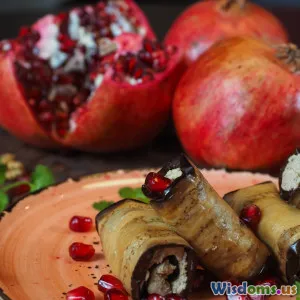
10 Surprising Herbs You Should Grow and Cook With This Season
10 min read Discover 10 unique herbs to grow and cook with this season, enhancing your garden and kitchen with flavor and nutrition. (0 Reviews)
10 Surprising Herbs You Should Grow and Cook With This Season
As the season unfolds, gardeners and culinary enthusiasts alike find renewed inspiration to dive into fresh, aromatic additions for their dishes. While basil, mint, and parsley may be kitchen staples, stepping beyond these classics unveils a world of extraordinary herbs that boast unique flavors, medicinal benefits, and easy garden-growing potential. This article uncovers ten surprising herbs that are both delightful and practical for this season, encouraging you to cultivate green pockets bursting with culinary creativity.
Why Grow Uncommon Herbs?
Gifted with culinary versatility and health-promoting phytochemicals, uncommon herbs bring more than just aroma to your garden and kitchen. According to Dr. Jessica Lautenbach, a renowned botanist, "Integrating diverse herbs into your diet not only elevates flavors but also introduces antioxidants and essential oils that aid digestion and immunity."
Beyond health, these herbs often require minimal care, thrive in various climates, and deter pests naturally, contributing to more sustainable gardening practices.
1. Lemon Verbena (Aloysia citrodora)
What Is It?
Lemon Verbena is a highly fragrant herb, renowned for its bright citrus scent far stronger than many lemons themselves.
Why Grow It?
This herb loves warmth and sun but can thrive in pots indoors if the weather is cooler. Its leaves add delightful notes to teas, desserts, and even savory dishes like grilled chicken.
Culinary Uses
Infuse fresh lemon verbena leaves into custards, fruit salads, and herbal teas for a refreshing twist. Chef Ana Ros praises it: "Lemon Verbena’s scent transforms simple meals into sensory experiences."
2. Shiso (Perilla frutescens)
What Is It?
Shiso, a member of the mint family, comes in green and purple varieties with an intriguing combination of basil, mint, and citrus flavors.
Why Grow It?
Popular in Japanese and Korean cuisines, shiso enjoys warm conditions and grows rapidly. It’s excellent for containers and home gardens.
Culinary Uses
Slice fresh shiso into salads, sushi, or use it to wrap grilled meats. Beyond taste, it adds a vivid color contrast and a delicate aromatic profile.
3. Culantro (Eryngium foetidum)
What Is It?
Often confused with cilantro, culantro has deeper, more robust flavors and is favored in Caribbean, Latin American, and Asian dishes.
Why Grow It?
It thrives in shade and moist soil, making it perfect for less sunny yards. Culantro is also heat tolerant—the perfect companion through warmer months.
Culinary Uses
Use culantro to season soups, stews, and marinades where a bold, earthy herbaceous note is needed. It holds well under heat unlike cilantro.
4. Vietnamese Coriander (Persicaria odorata)
What Is It?
Also known as Rau Ram, this herb offers a peppery, lemon-like flavor, distinct from cilantro but equally impactful in Southeast Asian cooking.
Why Grow It?
It flourishes in wet, warm environments, making it ideal for containers or garden beds with rich, moist soil.
Culinary Uses
Commonly added to soups, fresh spring rolls, and salads to impart a zingy, refreshing burst of flavor.
5. Lemon Balm (Melissa officinalis)
What Is It?
A member of the mint family, lemon balm offers a subtle lemon aroma and is treasured for its calming properties.
Why Grow It?
Its resilience to different sunlight levels and drought tolerance makes it easy for novices to cultivate.
Culinary Uses
Perfect in teas, syrups, and desserts; a few leaves can brighten salad dressings or poached fruit.
Dr. Louise Myers highlights lemon balm's neuroprotective traits, noting it "may help reduce stress and promote better sleep."
6. Epazote (Dysphania ambrosioides)
What Is It?
A staple in Mexican cooking, epazote offers a pungent flavor somewhat reminiscent of oregano, anise, and citrus.
Why Grow It?
This hardy herb grows rapidly, tolerating warmer climates with minimal water, ideal for gardeners seeking low-maintenance plants.
Culinary Uses
Traditionally added to bean dishes to reduce gas and impart a distinctive flavor. It pairs well with corn and squash-based recipes.
7. Salad Burnet (Sanguisorba minor)
What Is It?
Salad Burnet is a unique perennial herb with delicate leaves tasting slightly like cucumber.
Why Grow It?
It prefers cooler climates and shaded spots, tolerates poor soils and self-seeds readily.
Culinary Uses
Add fresh leaves to salads, cold soups like gazpacho, or cucumber-based drinks for subtle freshness.
8. Fenugreek (Trigonella foenum-graecum)
What Is It?
More than just a spice, fenugreek leaves (known as methi) offer a unique aromatic bitterness used widely across South Asian cuisine.
Why Grow It?
Fast-growing and drought tolerant, fenugreek enriches your edible garden and provides both fresh leaves and seeds for seasoning.
Culinary Uses
Use fresh fenugreek in curries, parathas, and dals. When dried, its seeds provide a sweet-nutty flavor commonly in spice blends like garam masala.
9. Lovage (Levisticum officinale)
What Is It?
Lovage resembles celery but boasts a more intense, aromatic flavor.
Why Grow It?
It grows tall and thrives in full sun to partial shade, providing abundant leaves and stalks.
Culinary Uses
Use lovage's leaves and stems to enrich soups, stocks, salads, or as a substitute for celery in many recipes.
10. Borage (Borago officinalis)
What Is It?
Known as starflower, borage is striking with its blue star-shaped flowers and cucumber-like flavor.
Why Grow It?
It tolerates poor soils and self-seeds prolifically. Besides adding flavor, it is a powerful pollinator attractor, beneficial for the entire garden.
Culinary Uses
Harvest young leaves for salads and drinks; decorate desserts or cocktails with vibrant borage flowers for color and subtle flavor.
Tips for Growing and Cooking These Herbs
- Start with Good Soil: Herbs thrive in well-draining, nutrient-rich soil. Regularly amend your garden soil with compost for best results.
- Container Gardening: Many of these herbs do wonderfully in pots. This method controls soil quality and protects plants from pests.
- Watering Wisely: Most herbs need consistent moisture but avoid soggy soil. Observing each herb’s preference ensures robust growth.
- Harvesting: Pick herbs in the early morning, just after dew, for the freshest flavor and peak essential oil concentration.
- Experiment in Cooking: Try infusing oils, blending herbs in pestos, or pairing them with unusual foods to discover new taste combinations.
Conclusion
This season, enhancing your culinary and gardening experience by cultivating these ten surprising herbs is a flavorful adventure that pays rich dividends. From the citrusy zest of lemon verbena and lemon balm to the boldness of epazote and culantro, your garden can become a vibrant pantry teeming with possibilities. Beyond taste, these herbs offer health benefits, resilience, and aesthetic value to your outdoor space. Embrace the opportunity to grow, harvest, and creatively cook with these herbs — your palate and wellbeing will thank you.
Remember, gardening is not only about planting seeds in the soil but sowing the seeds of curiosity, sustainability, and joy in your lifestyle. So, grab your gardening gloves, prepare your pots, and embark on this fragrant journey rich with flavor and surprises.
References:
- Lautenbach, J. (2022). Heirloom Herbs: Their Effects and Nutritional Benefits. Botanical Press.
- Myers, L. (2023). "The calming properties of lemon balm," Phytotherapy Journal, 18(2), 45-50.
- Ros, A. (2024). Personal communication, Flavor Profile Insights.
- University of California Master Gardener Program: Herb Cultivation Guides.
Unlock the potential of your garden with these ten surprising herbs today!
Rate the Post
User Reviews
Popular Posts















